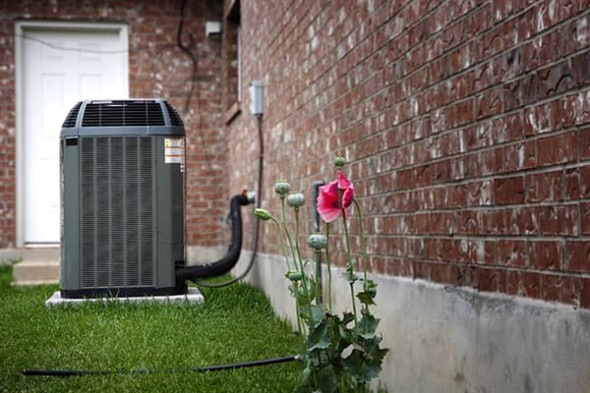Switching to an Electric Heat Pump
Posted on February 15, 2024 by Cassie Allen
Tags, Oregon Utilities 101, Energy, General Interest

The way you heat and cool your home has a big impact on your bill and the environment. According to Energy Star, nearly half of the energy used in your home goes directly to heating and cooling.
Most home energy systems last for ten to twenty years, so it’s important to choose the right heating and cooling system for your needs. Switching from a gas furnace to an electric heat pump can make a big impact on your bills and the environment.
In this blog, we’ll talk about heat pumps, how they work, and how to make the switch in Oregon.
What is a heat pump?
Heat pumps are a great solution for efficient electric heating and cooling. A heat pump is part of a home heating and cooling system that’s installed outside your home. Similar to a central air conditioning system, it can cool your home, but it can also provide heat.
During the winter, an electric heat pump pulls heat from the cold air and moves it into your home. During the summer, it pulls heat from the indoor air and pumps it outside to cool your home.
Electric heat pumps work differently than gas furnaces. While a gas furnace burns natural gas to generate heat, an electric heat pump transfers heat from the outdoor air to indoors. Because they handle both cooling and heating, homeowners may not need to install separate systems to heat and cool their homes.
Heat pumps can be ducted or ductless. A ducted heat pump works much like a traditional heating/cooling system. You set your thermostat to the desired temperature and the system blows that air throughout your home using ducts.
A ductless heat pump is installed in a wall, typically one facing outside. The small unit called a “mini-split” heat pump, heats and cools that individual room or section of the home.
I am happy that I made the switch to an electric heat pump. I burn less fossil fuel than before and consume much less energy while heating and cooling my home.
-Sudeshna Pal, former CUB staff
Read more here: My Experience Switching to an Electric Heat Pump
Are heat pumps more efficient than gas furnaces?
All HVAC systems come with an efficiency rating, usually measured by percentage. The percentage is the amount of energy used by the system vs. how much heat it generates (or removes when looking at cooling systems).
For gas heaters, the efficiency range is determined by the model type and the age of the furnace. According to Energy Saver, older, low-efficiency heating systems range between 56-70 percent efficient. A mid-efficiency system is between 80-83 percent. A high-efficiency gas furnace is between 90-98.5 percent.
Heat pumps, by contrast, are in the range of 200-300 percent efficient. This means that a heat pump will add or remove heat (thermal energy) from your home at a higher rate than it uses energy from the electrical grid. Heat pumps use significantly less energy than other HVAC options, saving you money on your bills.

Photo credit: Heat Pumps on the Rise
Ready to make the switch?
Now that you’re sure a heat pump is right for your home, here are some next steps for making the switch:
Review Incentives and Eligibility
There are several incentive programs available in Oregon for people who want to purchase an electric heat pump. The Energy Trust of Oregon currently offers cash incentives for people looking to make the switch.
You can also use the Energy Trust of Oregon’s incentive search tool to find incentives based on your residence type, utility provider, and zip code.
Gather Estimates and Find a contractor
When looking to install an electric heat pump in your home, choosing a contractor is a key step in making sure your energy efficiency project goes smoothly. Hiring an unlicensed contractor or one unfamiliar with the requirements of the job can lead to all kinds of issues. Thankfully, there are many resources available to make your project a success.
Try out the Energy Trust of Oregon’s Find a Contractor tool to look for a licensed contractor in your area. You can also use the following tips while looking for a contractor:
- Verify your contractor has the correct licenses for the job on the Oregon Construction Contractor’s Board website.
- Check online resources such as Angi (Formerly Angie’s List) or the Better Business Bureau to see how the contractor is rated.
- Review your bid and understand the work to be performed.
- Ask friends and family for recommendations.
Complete your Installation and Apply for your Incentive
Once you’ve researched incentives and found a contractor, the next step is to complete the installation of your heat pump. Your contractor should work with you to determine what will be the correct product for your home.
After your contractor has completed their work, you then can apply for your incentive. You can begin the application process by going to the Energy Trust of Oregon’s Online Application for Residential Incentives.
Applications must be received within 60 days of installation and need six to eight weeks for processing. Your contractor may help you with your application. Be sure you have the installation date, equipment serial/model number, and efficiency rating, and include a scan or legible digital photo of your contractor’s invoice.
Lastly, make sure to maintain your investment and enjoy your energy savings!
Stay Up to Date on Oregon Utility Issues
CUB will continue to advocate for people in Oregon on major utility issues. Sign up for the CUB email list for the latest updates, action alerts, and news on policies that affect the utilities your home relies on.
To keep up with CUB, like us on Facebook and follow us on Twitter!




02/15/24 | 1 Comment | Switching to an Electric Heat Pump